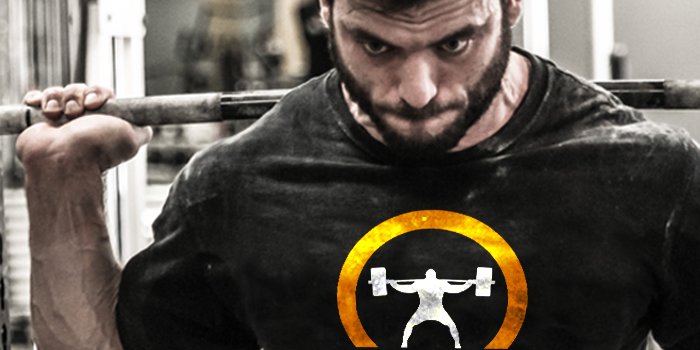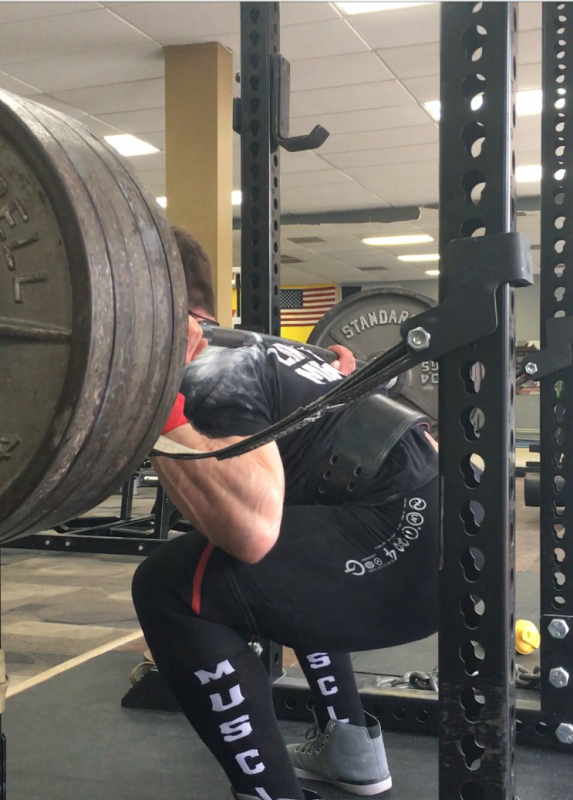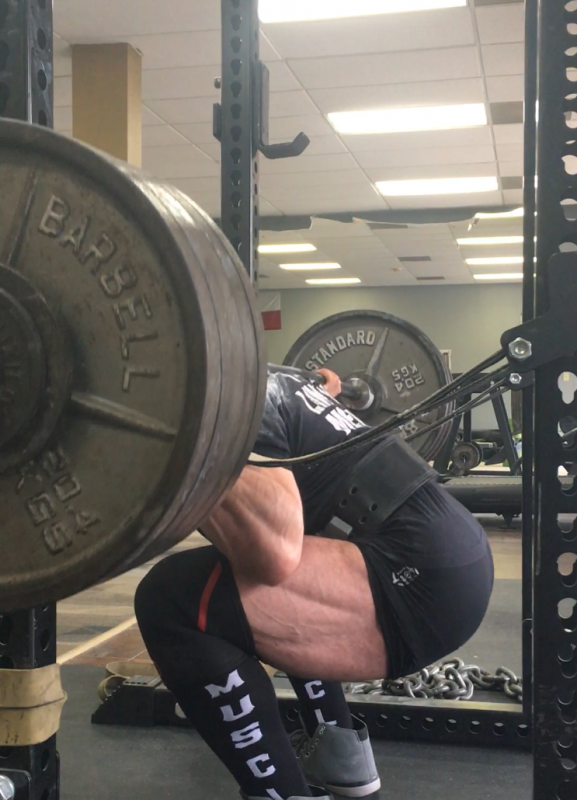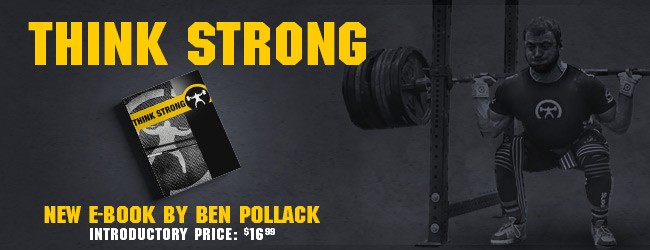
The BB for PL series describes how you can incorporate bodybuilding exercises into your powerlifting training for big benefits in strength and aesthetics. So far, this series has covered some special exercises for your abs, glutes, and rear delts. This third installment tackles the easily-forgotten adductors, the muscles that make your inner quads pop and help you keep your knees in a good position on the squat. If you’re struggling with quad development, knee pain, or squat depth, then read on.
Clever Heading about Quad Sweep
Bashing bodybuilders for having small legs is old news: by now, most everybody knows that if you don’t squat, you don’t really even lift. But really great quads require more than just a big squat, because training your legs exclusively with that movement will lead to imbalances in the hamstrings, vastus medialis (teardrop) and inner quad sweep. This article focuses on the latter. There aren’t a whole lot of exercises that develop the inner quad, other than the infamous yes/no machine, and unless you’re already jacked AF, you might not want to be seen using that particular device right around Valentine’s Day.
Good news: there are other, more effective exercises you can use to target your adductors and improve your inner quad. And those same exercises can help add a whole bunch of weight to your squat, which can help take you out of DYEL territory real quick.
Do You Know Squat About Your Adductors?
Adductors are an important muscle group for stabilization in the squat, but they often get overlooked in favor of the more obvious quads, hamstrings, and glutes. Your glutes in particular work to abduct your hips, but they can’t function properly without strong supporting adductors.
Anatomy
The adductors are actually a group of muscles that run from your pelvis to your knee and help you move your knees in, closer to the center of your body. Few lifts actually require this type of movement — you almost always want to keep your knees in line with your toes, keeping a balance between abduction and adduction. That means your adductors still need to be strong and flexible, even if you’re keeping your knees out. But your adductors rarely get as much direct work as your hamstrings, glutes, and quads, and as you strengthen those muscle groups, the adductors might struggle to keep up.
Imbalanced muscle groups, overuse, and even poor sitting posture can all contribute to tight, inhibited adductors, and that’s a problem, whether you’re a bodybuilder or powerlifter. If you’re training primarily for aesthetics, you might get away with some extra volume work on the hip adduction machine. If you’re concerned about performance, you’ll want to keep reading.
Problems in the Squat Caused by Weak Adductors
So, if your adductors aren’t functioning optimally, you’re going to have a hard time squatting to depth — either because you won’t be able to keep your knees from pulling in, or because inner knee pain just gets too intense.
Try thinking about it like this. Say your quads, hamstrings, and glutes are capable of handling 500 pounds in the squat, but (because of weakness, tightness, or overuse), your adductors can only handle 400. So if you’re using 400 pounds, everything feels great: the weights are moving fast, you’re going deep, and it feels like you’re training with about 80% of your 1RM. Remember, the adductors are mainly stabilizing your knee position — so you might not realize that they’re straining with a maximal load.
But go up to just 425 pounds — 85% of what you’d expect your 1RM to be, based solely on your major muscle groups — and all of a sudden, your adductors say “nah, fam,” and leave those bigger muscles hanging, unable to fully contribute to the movement. Your glutes can’t abduct your hips properly, so your knees stay tracking too far it, so you can’t hit depth; and your hamstrings can’t help control your descent as well, so you’re more likely to fall out of position and struggle to even stand up. Not a good look.
Strengthening & Activating the Adductors
Fortunately, there are some answers. First, if you haven’t been training your adductors at all, you’ll want to start with some mobility and activation work so that you can recruit them properly during your leg training. Once you’ve got a handle on your adductors and how they work, you can start strengthening them. The good news? It won’t take long to bring even very weak adductors up to par.
Exercise 1: Lateral Hip Distraction with elitefts Average Band
- Loop one end of a band around the bottom of a power rack, on the side of your body that you want to train.
- Lie flat on your back on the floor behind the rack, with hips neutral and core braced. Bend your knee nearest the band and loop the other end of the band around the inside that knee. You’ll want to position yourself far away enough from the band so that there is lateral tension on your knee, pulling it away from your body.
- Adduct your knee, bringing it across your body as far as you can. You can use the opposite post of the power rack for leverage. Hold that position for 1-2 seconds.
- Let the band slowly abduct your knee, pulling it back to the starting position. Resist the band gently during this eccentric portion of the exercise.
- Repeat for 8-12 total repetitions, and then repeat for the other side of your body.
Exercise 2: Hack Squat with Mini Foam Roller
- Position yourself on an unloaded hack squat machine with a fairly narrow stance.
- Place a mini foam roller between your knees and thighs, and hold it in place by squeezing with your adductors.
- Perform hack squats as usual, being sure to press through your heels, not your toes.
- Once you’re comfortable with the movement, you can add weight to the hack squat, but stick to fairly light loads and higher reps (10-20).
Exercise 3: Hip Adduction with elitefts Light Band
- Sit on a chair or lie flat on your back on the floor with hips neutral.
- Loop a light band around one knee, so that part of the band is above the knee (on the quad) and part is below the knee (on the shin).
- Pull the band under your hips and loop it around your opposite knee in exactly the same way. You’ll want the band above your butt so that it provides sufficient tension. You should feel the band pulling your knees apart, towards the floor.
- Squeeze your knees together and hold for 1 second. Then slowly return to the starting position.
- Repeat for high reps (25+).
The Results
The results from training and even just activating your adductors can be dramatic. Check out the differences I saw in a single session:
This was a light training day for squat, so I was using 65% of my wrapped max (520 pounds) for doubles with minimal rest. As you can see, my adductors were pretty tight at the beginning of my workout:
After the first set, I performed one (unweighted) set of 10 hack squats with a foam roller, followed by one set of 10 bottom-half bodyweight squats, to help activate my adductors and familiarize myself with the feeling of hitting depth while keeping my hips open. Here’s what my next set looked like:
In my opinion, that’s a pretty exciting change. If you struggle with depth, tight hips, or painful knees, try out some of adductor exercises and see if your situation improves — I think you’ll be pretty satisfied with the results.
Final Thoughts
A little adductor work can go a long way, so even if you’re not struggling with depth or knee pain, I really encourage you to do a little upkeep to make sure your adductors keep functioning properly. There’s no need to overdo it, though — make sure to keep getting in good work for your hamstrings, glutes, and quads so that all of your major muscle groups develop at a steady, balanced rate.
It’s old news by now, but if you have any suggestions for improving this article, or ideas for articles you’d like to see in the future, please let me know in the comments or shoot me an email at ben@phdeadlift.com!













9 Comments